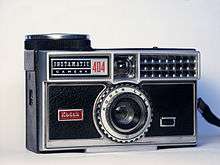Instamatic
The Instamatic is a series of inexpensive, easy-to-load 126 and 110 cameras made by Kodak beginning in 1963.[1] The Instamatic was immensely successful, introducing a generation to low-cost photography and spawning numerous imitators.
- For the film formats associated with the Instamatic and Pocket Instamatic camera ranges, see 126 film and 110 film respectively.


During its heyday, the range was so ubiquitous that the Instamatic name is still frequently used (erroneously) to refer to any inexpensive point-and-shoot camera. (It is also frequently used incorrectly to describe Kodak's line of instant-picture cameras, the Kodamatic series.)
The Instamatic name was also used by Kodak on some Super 8-based home-cine cameras.[2]
History
.jpg)
.jpg)
Early Instamatics
The first Instamatics went on sale for $16 in early 1963 [3] and were soon followed by the 300 (which had a light meter), the 400 (which had a light meter and a spring driven film advance), and the 700 (which had a light meter, focusing, and selectable shutter speeds).[4] They were the first cameras to use Kodak's new 126 format. The easy-load film cartridge made the cameras very inexpensive to produce, as it provided the film backing plate and exposure counter itself and thus saved considerable design complexity and manufacturing cost for the cameras. A wide variety of print and slide film was sold by Kodak in the 126 format.
The lead designer for the Instamatic program was Dean M. Peterson (original design by Alexander Gow), also later known for most of the innovations in the point-and-shoot camera revolution of the 1980s. The first Instamatic to be released was the Instamatic 50, which appeared in the UK in February 1963, about a month before the 100. The first model released in the US was the basic Instamatic 100. With fixed shutter speed of 1/90 of a second,[5] aperture and focus, it continued in the tradition of Kodak's earlier Brownie cameras, providing a simple snapshot camera anyone could use. It also featured a built-in flashgun for AG-1 "peanut" bulbs, a feature lacking in the 50.
The lineup was soon expanded to include a variety of models from the basic but popular 100/104 to the automatic exposure 800/804, which featured an aluminum chassis, rangefinder, selenium light meter, and clockwork spring wind. (The 100/104 designation refers to the type of flash: models ending in 0 had a built-in flashgun, while those ending in 4 used flashcubes.) The best model made in the USA was the 814, which had a four-element lens and a coupled range-finder.[6] The top-of-the-line model was the Instamatic Reflex SLR, which was made in Germany and could accept a variety of Retina S-mount lenses.
Commercial success
The Instamatic was an instant success; more than 50 million Instamatic cameras were produced between 1963 and 1970.[1] Kodak even gave away a considerable number in a joint promotion with Scott paper towels in the early 1970s in order to generate a large number of new photographers and stimulate lasting demand for its film business.
Many other manufacturers attempted to capitalize on the popularity of the Instamatic with their own 126 cameras, including Canon, Olympus, Minolta, Ricoh, Zeiss Ikon, and even Rollei. Some of these models were far more sophisticated and expensive than the Kodak cameras: the Rollei SL26, for instance, featured interchangeable lenses, TTL metering, and a rangefinder, and retailed for $300.
A new series of Instamatics was introduced in 1970 to take advantage of the new Magicube flash technology. Magicubes used mechanically triggered pyrotechnic detonators for each bulb, an improvement over flashcubes in that the need for batteries was eliminated. Instamatics with Magicube sockets were denoted by an "X" in the model number (e.g. X-15 or 55X).
"Pocket Instamatic" (110-format)
.jpg)
In 1972, Kodak introduced the Pocket Instamatic series for its new 110 format. The 110 cartridge had the same easy-load design as the 126 format but was much smaller, allowing the cameras to be very compact (hence the "Pocket" designation). The top-of-the-line model was the Pocket Instamatic 60, which featured a stainless steel body, rangefinder, and automatic exposure. More than 25 million Pocket Instamatics were produced in under three years, and the 110 format remained popular into the 1990s. However the small negative size limited quality when using the film emulsion of the period, although in practice most prints were small, so the poor quality was not apparent unless the prints were enlarged.
Mid-1970s to late 1980s
In 1976, the Instamatic X line was updated for use with the new Flipflash system. These cameras were designated by the addition of the suffix "F" to the model number of the corresponding Magicube model. The basic X-15F was the last Instamatic sold in the United States, remaining on sale until 1988.
See also
References
- Tom Tobin (2013-03-29). "Kodak Instamatic camera turns 50". Usatoday.com. Retrieved 2015-05-09.
- Kodak Movie Cameras, nwmangum.com. Article retrieved 2006-11-09.
- Gustavson, Todd (2011). 500 Cameras 170 years of photographic innovation. Sterling Signature. ISBN 978-1-4027-8086-8.
- "Popular Mechanics". Hearst Magazines. October 1963.
- "Instamatic Retro : Kodak Instamatic 100". Instructables.com. 2008-07-27. Retrieved 2015-05-09.
- "Popular Mechanics". Hearst Magazines. July 1969.
External links
![]()